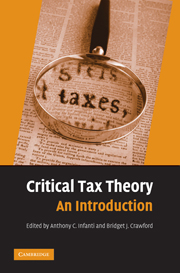Book contents
- Frontmatter
- Contents
- List of Illustrations
- List of Tables
- List of Contributors
- List of Common Abbreviations
- Introduction
- CHAPTER 1 FOUNDATIONS OF CRITICAL TAX THEORY
- CHAPTER 2 HISTORICAL PERSPECTIVES ON TAXATION
- Dollars and Selves: Women's Tax Criticism and Resistance in the 1870s
- Split Income and Separate Spheres: Tax Law and Gender Roles in the 1940s
- The Rhetoric of the Anti-Progressive Income Tax Movement: A Typical Male Reaction
- CHAPTER 3 THE GOALS OF TAX POLICY
- CHAPTER 4 CRITICAL TAX THEORY MEETS PRACTICE
- CHAPTER 5 RACE AND TAXATION
- CHAPTER 6 GENDER AND TAXATION
- CHAPTER 7 SEXUAL ORIENTATION AND TAXATION
- CHAPTER 8 THE FAMILY AND TAXATION
- CHAPTER 9 CLASS AND TAXATION
- CHAPTER 10 DISABILITY AND TAXATION
- CHAPTER 11 GLOBAL CRITICAL PERSPECTIVES ON TAXATION
- CHAPTER 12 CRITICAL PERSPECTIVES ON CRITICAL TAX THEORY
- Index
Dollars and Selves: Women's Tax Criticism and Resistance in the 1870s
Published online by Cambridge University Press: 04 August 2010
- Frontmatter
- Contents
- List of Illustrations
- List of Tables
- List of Contributors
- List of Common Abbreviations
- Introduction
- CHAPTER 1 FOUNDATIONS OF CRITICAL TAX THEORY
- CHAPTER 2 HISTORICAL PERSPECTIVES ON TAXATION
- Dollars and Selves: Women's Tax Criticism and Resistance in the 1870s
- Split Income and Separate Spheres: Tax Law and Gender Roles in the 1940s
- The Rhetoric of the Anti-Progressive Income Tax Movement: A Typical Male Reaction
- CHAPTER 3 THE GOALS OF TAX POLICY
- CHAPTER 4 CRITICAL TAX THEORY MEETS PRACTICE
- CHAPTER 5 RACE AND TAXATION
- CHAPTER 6 GENDER AND TAXATION
- CHAPTER 7 SEXUAL ORIENTATION AND TAXATION
- CHAPTER 8 THE FAMILY AND TAXATION
- CHAPTER 9 CLASS AND TAXATION
- CHAPTER 10 DISABILITY AND TAXATION
- CHAPTER 11 GLOBAL CRITICAL PERSPECTIVES ON TAXATION
- CHAPTER 12 CRITICAL PERSPECTIVES ON CRITICAL TAX THEORY
- Index
Summary
It is true that most people will when I talk of our claim on the ground of human rights, blink like owls in the daylight; but they understand me at once, when I speak of my right to look after the dollars which I have paid as a tax. In short, they understand the worth of my dollars, and my right to look after them, but do not understand what above all I hold of worth – my personal self and my right to represent it.
– Mary Eastman, 1877Although women's history scholars have mentioned tax protests and refusals to pay in the woman suffrage movement, relatively little analysis has been devoted to these issues. Key to understanding both the dollars and the selves taxation arguments is an appreciation of the centrality of metaphor.
By trying to use familiar historical narratives of the Revolutionary era [e.g., no taxation without representation] as vehicles to explain or reveal something of women's tax protests and resistance in the 1870s, woman suffragists used a metaphor that was generative of later policy decisions and adverse consequences for the women's movement. The selves arguments were bottomed on metaphoric employment of taxation outside its familiar context of governmental exactions. In writings from the 1870s, taxation was critical to an understanding of gender within society. The selves taxation arguments used by woman suffragists in the 1870s were an attempt both to set forth a meaning for “taxation,” an important symbol in American political life, and to use “taxation” to “limit and contain the metaphoric possibilities” of other cultural constructs.
- Type
- Chapter
- Information
- Critical Tax TheoryAn Introduction, pp. 13 - 21Publisher: Cambridge University PressPrint publication year: 2009



